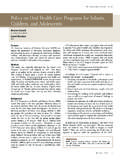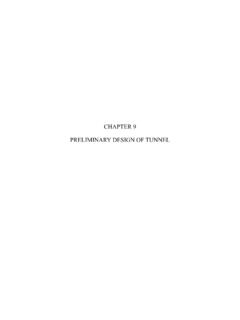Transcription of Guideline on Restorative Dentistry - AAPD
1 REFERENCE MANUAL V 38 / NO 6 16 / 17. Guideline on Restorative Dentistry Review Council Council on Clinical Affairs Latest Revision 2016*. Purpose The assessment of evidence for each topic was based on a The American Academy of Pediatric Dentistry (AAPD) in- modification of the American Dental Association's grading tends this Guideline to help practitioners make decisions of recommendations: strong evidence (based on well-executed regarding Restorative Dentistry , including when it is necessary randomized control trials, meta-analyses, or systematic re- to treat and what the appropriate materials and techniques views); evidence in favor (based on weaker evidence from are for Restorative Dentistry in children and adolescents. clinical trials); and expert opinion (based on retrospective trials, case reports, in vitro studies, and opinions from clinical Methods researchers).1. A thorough review of the scientific literature in the English This Guideline was originally developed by the Restorative language pertaining to Restorative Dentistry in primary and Dentistry Subcommittee of the Clinical Affairs Committe permanent teeth was completed to revise the previous guide- and adopted in 1991.
2 The last comprehensive revision of this line. Electronic database and hand searches, for the most document was in 2014. part between the years 1995-2013, were conducted using the terms: Restorative treatment decisions, caries diagnosis, caries When to restore excavation, dental amalgam, glass ionomers, resin modified Historically, the management of dental caries was based on glass ionomers, conventional glass ionomers, atraumatic/ the belief that caries was a progressive disease that eventually alternative Restorative technique (ART), interim therapeutic destroyed the tooth unless there was surgical and Restorative restoration (ITR), resin infiltration, dental composites, pit and It is now recognized that Restorative treatment fissure sealants, resin-based sealants, glass ionomer sealants, of dental caries alone does not stop the disease process3 and resin based composite, dental composites, compomers, stainless restorations have a finite lifespan.
3 Conversely, some carious steel crowns (SSC), primary molar, preformed metal crown, lesions may not progress and, therefore, may not need resto- strip crowns, pre-veneered crowns, esthetic restorations, clinical ration. Consequently, contemporary management of dental trials and, randomized controlled clinical trials. caries includes identification of an individual's risk for caries Those papers that were used to evaluate clinical efficacy on progression, understanding of the disease process for that specific Restorative Dentistry topics ( , amalgam, resin-based individual, and active surveillance to assess disease progression composite) initially were evaluated by abstract by two indi- and manage with appropriate preventive services, supple- viduals. Criteria for evaluation included if the paper fulfilled mented by Restorative therapy when the qualification of a controlled clinical trial, meta-analysis, With the exception of reports of dental examiners in clin- or systematic review.
4 Full evaluation and abstraction included ical trials, studies of reliability and reproducibility of detecting examination of the research methods and potential for study dental caries are not There also is minimal in- bias ( , patient recruitment, randomization, blinding, subject formation regarding validity of caries diagnosis in primary loss, sample size estimates, conflicts of interest, statistics). teeth,2 as primary teeth may require different criteria due to Research that was considered deficient or had high bias was thinner enamel and dentin and broader proximal eliminated. In those topic areas for which there were rigorous Furthermore, indications for Restorative therapy only have meta-analyses or systematic reviews available, only those clin- been examined superficially because such decisions generally ical trial articles that were not covered by the reviews were have been regarded as a function of clinical judgment.
5 7. subjected to full evaluation and abstraction. This strategy Decisions for when to restore carious lesions should include yielded 35 meta-analyses/systemic reviews and 62 randomized controlled clinical trials that primarily made up the evidence ABBREVIATIONS. for this Guideline . AAPD: American Academy of Pediatric Dentistry . ART: Alternative Restorative technique. ITR: Interim therapeutic restoration. SSC: Stainless steel crowns. RMGIC: Resin modified glass ionomer ce- ments. HT: Hall technique. GIC: Glass ionomer cement. FDA: Food *The 2016 revision is limited to the addition of Hall technique for preformed metal crowns. and Drug Administration. BPA: Bisphenol A. 250 CLINICAL PRACTICE GUIDELINES. AMERICAN ACADEMY OF PEDIATRIC Dentistry . at least clinical criteria of visual detection of enamel cavita- tion compared to complete excavation in teeth with a normal tion,visual identification of shadowing of the enamel, and/ pulp or reversible pulpitis.
6 Two trials and a Cochrane review or radiographic recognition of enlargement of lesions over found that partial excavation resulted in significantly fewer ,8,9 pulp exposures compared to complete Two trials The benefits of Restorative therapy include: removing of step-wise excavation showed that pulp exposure occurred cavitations or defects to eliminate areas that are susceptible to more frequently from complete excavation compared to step- caries; stopping the progression of tooth demineralization; wise excavation. 15,20 There also is evidence of a decrease in restoring the integrity of tooth structure; preventing the spread pulpal complications and post-operative pain after incom- of infection into the dental pulp; and preventing the shifting plete caries excavation compared to complete excavation in of teeth due to loss of tooth structure. The risks of Restorative clinical trials,15,20,22,23 summarized in a therapy include lessening the longevity of teeth by making Additionally, a meta-analysis found the risk for permanent them more susceptible to fracture, recurrent lesions, restora- restoration failure was similar for incompletely and completely tion failure, pulp exposure during caries excavation, future excavated With regard to the need to reopen a tooth pulpal complications, and iatrogenic damage to adjacent with partial excavation of caries, one randomized controlled ,11,12 Primary teeth may be more susceptible to restora- trial that compared partial (one-step) to stepwise excavation in tion failures than permanent teeth.
7 13 Additionally, before permanent molars found higher rates of success in maintain- restoration of primary teeth, one needs to consider the length ing pulp vitality with partial excavation, suggesting there is no of time remaining prior to tooth exfoliation need to reopen the cavity and perform a second Interestingly, two randomized controlled trials suggest that Recommendations: no excavation can arrest dental caries so long as a good seal of 1. Management of dental caries includes identification of the final restoration is ,25. an individual's risk for caries progression, understanding of the disease process for that individual, and active Recommendations surveillance to assess disease progression and manage 1. There is evidence from randomized controlled trails and with appropriate preventive services, supplemented by systematic reviews that incomplete caries excavation in Restorative therapy when indicated. primary and permanent teeth with normal pulps or re- 2.
8 Decisions for when to restore carious lesions should in- versible pulpitis, either partial (one-step) or stepwise clude at least clinical criteria of visual detection of (two-step) excavation, results in fewer pulp exposures enamel cavitation, visual identification of shadowing of and fewer signs and symptoms of pulpal disease than the enamel, and/or radiographic recognition of enlarge- complete excavation. ment of lesions over time. 2. There is evidence from two systematic reviews that the rate of restoration failure in permanent teeth is no higher Deep caries excavation and restoration after incomplete rather than complete caries excavation. Among the objectives of Restorative treatment are to repair or 3. There is evidence that partial excavation (one-step) fol- limit the damage from caries, protect and preserve the tooth lowed by placement of final restoration leads to higher structure, and maintain pulp vitality whenever possible.
9 The success in maintaining pulp vitality in permanent teeth AAPD Guideline on Pulp Therapy for Primary and Immature than stepwise (two-step) excavation. Permanent Teeth states the treatment objective for a tooth affected by caries is to maintain pulpal vitality, especially in Pit and fissure sealants immature permanent teeth for continued Pit and fissure caries account for approximately 80 to 90 per- With regard to the treatment of deep caries, three methods cent of all caries in permanent posterior teeth and 44 percent of caries removal have been compared to complete excava - in primary teeth9. Pit and fissure sealant has been described as tion, where all carious dentin is removed. Stepwise excavation a material placed into the pits and fissures of caries-susceptible is a two-step caries removal process in which carious dentin is teeth that micromechanically bonds to the tooth preventing partially removed at the first appointment, leaving caries over access by cariogenic bacteria to their source of nutrients,27 thus the pulp, with placement of a temporary filling.
10 At the second reducing the risk of caries in those susceptible pits and fissures. appointment, all remaining carious dentin is removed and a With regard to evidence of effectiveness, a Cochrane review final restoration Partial, or one-step, caries excavation found that sealants placed on the occlusal surfaces of permanent removes part of the carious dentin, but leaves caries over the molars in children and adolescents reduced caries up to 48. pulp, and subsequently places a base and final ,17 months when compared to no According to a meta- No removal of caries before restoration of primary molars analysis of 24 studies, the overall effectiveness of auto- in children aged three to 10 years also has been reported 18 polymerised fissure sealants in preventing dental decay was 71. Evidence from randomized controlled trials and a systematic Another Cochrane review calculated that placement review shows that pulp exposures in primary and permanent of resin-based sealant in children and adolescent reduces caries teeth are significantly reduced using incomplete caries excava - incidence of 86 percent after one year and 57 percent at 48 to CLINICAL PRACTICE GUIDELINES 251.












